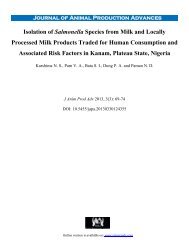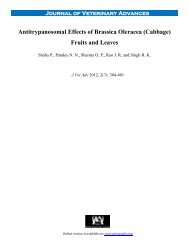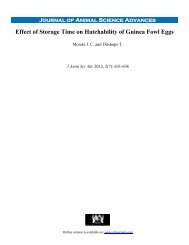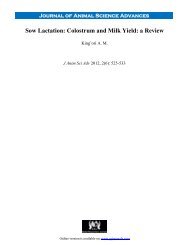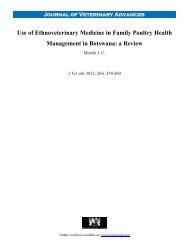PDF Download
PDF Download
PDF Download
Create successful ePaper yourself
Turn your PDF publications into a flip-book with our unique Google optimized e-Paper software.
Gram staining, morphological, biochemical, and<br />
physiological tests. Cell was grown on BHI agar to<br />
determine optimum growth condition for<br />
temperature (5-40 ºC) and in BHI broth for pH(4.0-<br />
8.0). pH of BHI broth was adjusted with HCl or<br />
NaOH. Acid production from carbohydrate, and<br />
utilization of sole carbon sources were determined<br />
using API tests (BioMerieux), including API 20E<br />
(identification system for Enterobacteriaceae and<br />
other Gram-negative rods) and API 20NE<br />
(identification system for gram-negative nonenterobacterial<br />
rods) galleries.<br />
Analysis of cellular fatty acid composition<br />
The cell biomass for cellular fatty acid<br />
composition analysis was collected from BHI agar<br />
plates after incubation for 5 days. Cells were<br />
harvested, and the cellular fatty acid was saponified,<br />
methylated and extracted following the instructions<br />
in the manual for Sherlock Microbial Identification<br />
System (MIDI, USA). The fatty acids were<br />
analyzed by gas chromatography (Hewlett Packard<br />
6890, USA) and identified using the Microbial<br />
Identification software package (16).<br />
Determination of 16S rDNA sequence and<br />
phylogenetic analysis<br />
Genomic DNA was isolated, and 16S rDNA<br />
was amplified by PCR and sequenced following the<br />
method described by Rainey et al. (17). Universal<br />
primers of fD1 (5’-GAGTTTGATCCTGGCTCAG-<br />
3’) and rD1 (5’-AGAAAGGAGGTGATCCAGCC-<br />
3’) were used for PCR. PCR products were purified<br />
by ethanol precipitation and electrophoresis with a<br />
model 377 Genetic Analyzer (Perkin-Elmer Co.).<br />
The 16S rDNA sequence was aligned against the<br />
previously determined sequences in Ribosomal<br />
Data of GenBank. The phylogenetic tree for the<br />
dataset was inferred using the neighbor-joining<br />
method (18).<br />
Assaying effect of temperature and pH on the<br />
β-galactosidase activity<br />
Effect of temperature on β-galactosidase<br />
produced in cell free extracts of KNOUC 302 was<br />
analyzed by measuring the enzyme activity at<br />
various temperatures (4 to 60 ºC) in 0.01 M sodium<br />
phosphate buffer (pH 6.8). Optimum pH for the β-<br />
galactosidase activity was determined by measuring<br />
the activity at various pHs(4.6 to 9.6) at 4 ºC in<br />
103 J. Anim. Prod. Adv., 2012, 2(2):<br />
NAM AND AHN<br />
sodium acetated buffer (0.01 M, pH 4.25-pH 6.0)<br />
and sodium phosphate buffer (0.01 M, pH 6.0-pH<br />
7.68). Enzyme stability was determined by<br />
measuring the residual activity during incubation of<br />
cell free extracts of KNOUC302 in sodium<br />
phosphate buffer (0.01 M, pH6.8) at 4 ºC and 37 ºC<br />
for 7 days.<br />
Cloning and sequence determination of β-<br />
galactosidase gene<br />
The chromosomal DNA of strain KNOUC302<br />
cells was isolated using a Genomic DNA Prep Kit<br />
(A&A Biotechnology, Poland) according to the<br />
protocol for gram-negative bacteria. The DNA was<br />
partially digested using Sau3A1 endonuclease, and<br />
4-10 kb fragments were collected and purified after<br />
electrophoresis in 0.8 % agarose gel using the DNA<br />
Gel Out Kit (A&A Biotechnology, Poland). To<br />
prepare genomic library, these DNA fragments<br />
were ligated into BamH1 site in pRSET (Promega,<br />
USA), transformed to E. coli TOP10F’ and<br />
incubated at 15 ºC for 3 days on LB agar containing<br />
100 ug ampicillin/mL, 100 ug/mL X-Gal without<br />
addition of IPTG. Colony was randomly taken for<br />
analysis. Sequence of the cloned DNA fragment<br />
was determined using Big Dye Automatic<br />
sequencer ABI 377 (Perkin Elmer, USA) and<br />
PE9600 Thermocycler (Perkin Elmer, USA).<br />
Results and Discussion<br />
Isolation and identification of bacterium<br />
producing cold-active β-galactosidase<br />
From raw milk samples collected from dairy<br />
farms of Northern Kyunggi province in Korea. 11<br />
strains having the activity of X-gal hydrolysis at 4<br />
ºC were isolated and KNOUC302 showed a good<br />
activity of ONPG hydrolysis and the highest<br />
activity of lactose hydrolysis (Table 1). Strain<br />
KNOUC302 was chosen, and it’s 16S rDNA,<br />
morphological and biochemical properties were<br />
examined for identification. The 16S rDNA of<br />
strain KNOUC302 was composed of 1,498bp<br />
(GenBank accession No. JN014467). BLAST<br />
searching revealed the highest similarity of 16S<br />
rDNA of strain KNOUC302 with those of<br />
Obesumbacterium proteus DSM 2777 T (98.9%<br />
identity) and Hafnia alvei ATCC 13337 T (99.8%<br />
identity) in phylogenetic tree (Fig. 1).<br />
Obesumbacterium sp. and Hafnia alvei are closely





